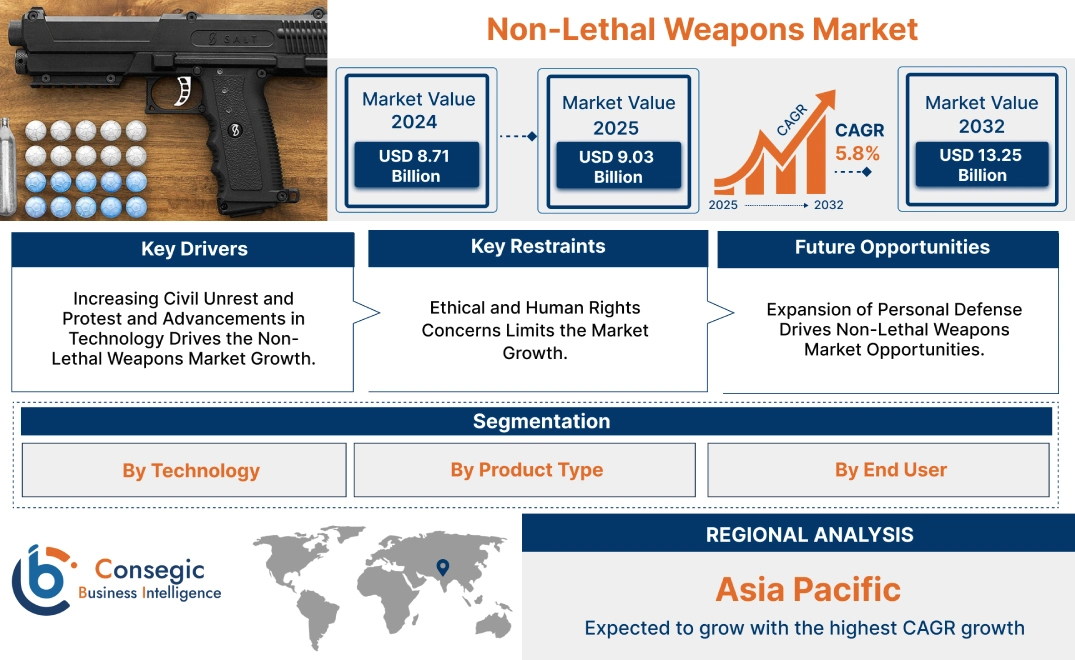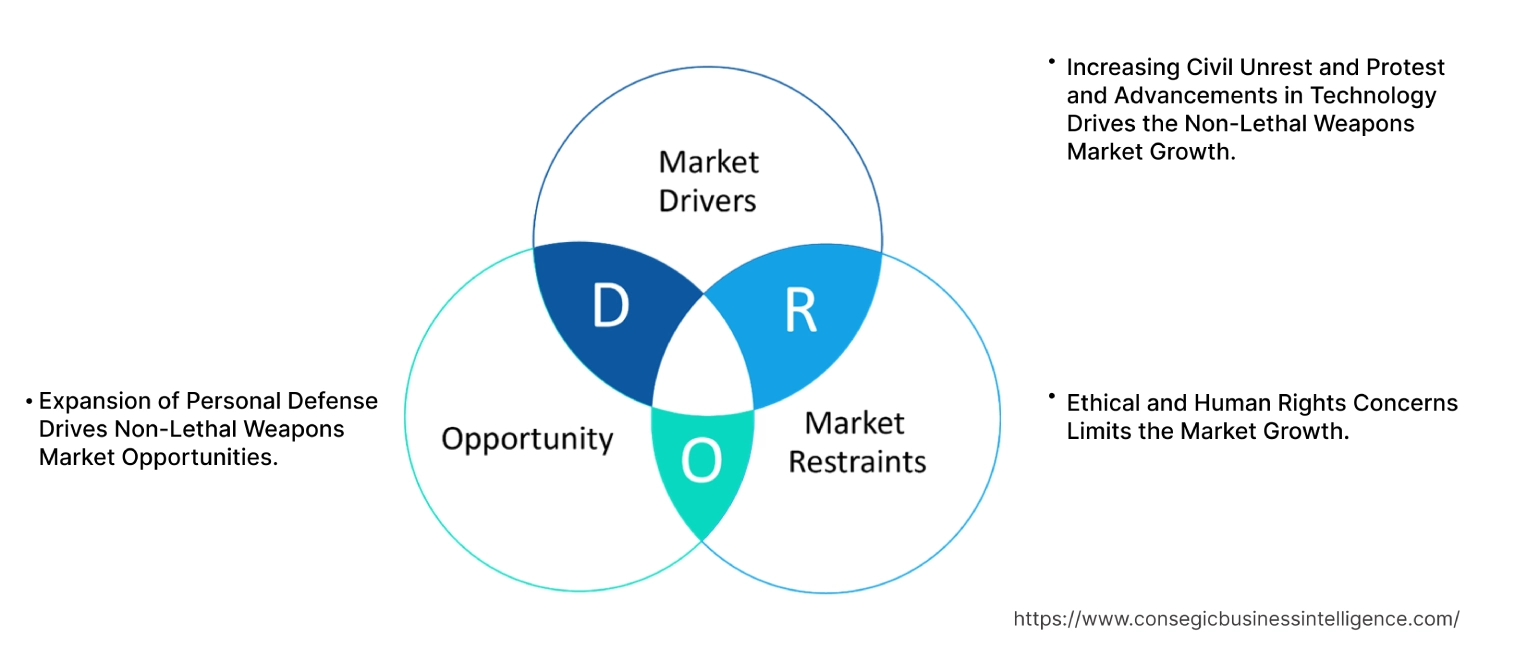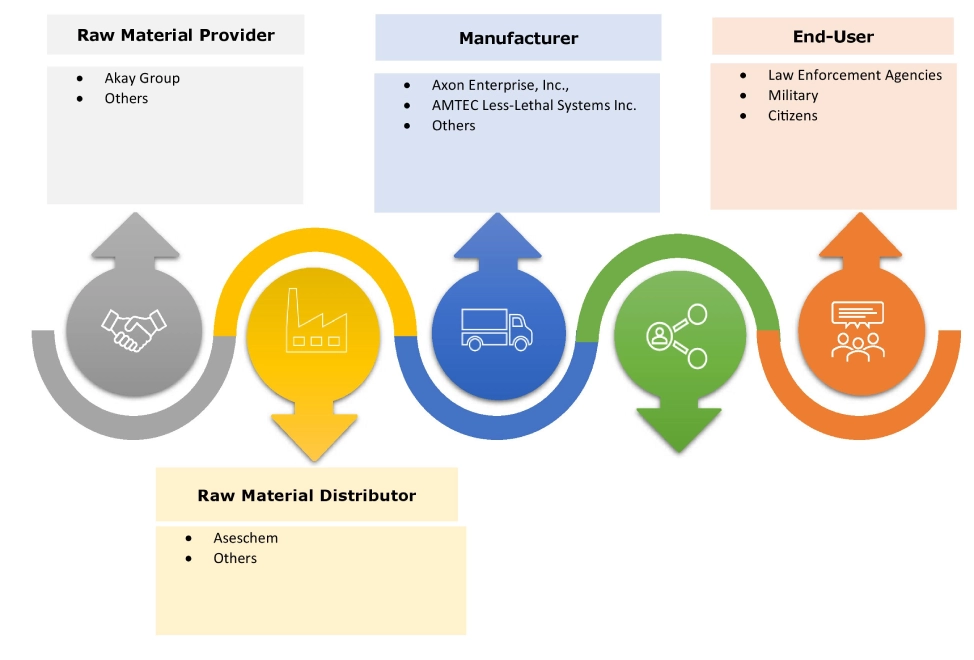- Summary
- Table Of Content
- Methodology
Non-Lethal Weapons Market Size:
Non-Lethal Weapons Market Size is estimated to reach over USD 13.25 Billion by 2032 from a value of USD 8.71 Billion in 2024 and is projected to grow by USD 9.03 Billion in 2025, growing at a CAGR of 5.8% from 2025 to 2032.
Non-Lethal Weapons Market Scope & Overview:
Non-lethal weapons are designed to weaken or deter individuals without causing fatalities or serious injuries, aiming to minimize harm while effectively managing threats. These tools employ a variety of technologies, including chemical irritants, kinetic impact, and electrical shocks, to achieve temporary incapacitation or disorientation. Further, non-lethal armaments are widely used in law enforcement and military operations and are also used for providing individuals with tools for effective self-defense. Furthermore, key trends driving the market include the increasing integration of smart technologies into non-lethal weapons, enhancing precision and accountability, and the growing need for versatile, multi-functional systems that can adapt to diverse operational scenarios.
Key Drivers:
Increasing Civil Unrest and Protest and Advancements in Technology Drives the Non-Lethal Weapons Market Growth.
The escalating frequency and intensity of civil unrest and protests globally have become a significant catalyst for the non-lethal weapons market. Law enforcement agencies and manned security service forces are increasingly seeking effective tools to manage crowds and de-escalate situations without resorting to deadly force. The requirement is further amplified by the rapid advancements in technology. Additionally, innovations in electroshock devices, acoustic systems, and chemical agents have led to more precise and targeted non-lethal solutions. Further, the development of advanced materials and delivery systems has also improved the safety and effectiveness of non-lethal weapons.
- For instance, according to Global Peace Index 2023 report by Institute for Economics & Peace in the last 15 years the world witnessed a five percent drop in overall peace levels. Specifically, the GPI reveals that nearly 60% of nations have become less peaceful, while only about 40% have seen improvements.
Thus, confluence of social pressures and technological innovation contributes significantly to the non-lethal weapons market size.
Key Restraints:
Ethical and Human Rights Concerns Limits the Market Growth.
The non-lethal weapons market faces significant limitations due to ethical and human rights concerns. The inherent potential for misuse and abuse of these technologies raises serious questions about proportionality and accountability. International organizations and human rights groups often express apprehension regarding the long-term health effects and the potential for these weapons to be used in oppressive or discriminatory ways. Further, scrutiny leads to stringent regulations and restrictions on the development and deployment of certain non-lethal technologies, impacting market growth. Public distrust and negative perceptions further complicate the issue, as the use of such weapons can erode community relations and undermine law enforcement legitimacy. Thus, increasing regulation and human rights concerns are limiting the market growth.
Future Opportunities :
Expansion of Personal Defense Drives Non-Lethal Weapons Market Opportunities.
The growing sense of personal vulnerability globally is significantly expanding the market opportunities for non-lethal weapons. As individuals increasingly prioritize self-defense, the need for accessible and effective tools rises. This surge drives innovation in compact, user-friendly devices like pepper sprays, stun guns, and personal alarms. Further, technological advancements are making these tools more reliable and precise, enhancing their appeal to a wider consumer base.
- For instance, SABRE - Security Equipment Corp. offers SABRE Pepper Spray provides maximum strength personal protection with a police-trusted formula and UV marking dye. Its flip-top design allows for quick and controlled deployment, preventing accidental discharge, while the intuitive grip ensures accurate aiming.
Thus, growing adoption of personal defense drives non-lethal weapons market opportunities.
Non-Lethal Weapons Market Segmental Analysis :
By Technology:
Based on the technology, the market is segmented into chemical, electroshock, mechanical and kinetic, acoustic/light, and others.
Trends in the Technology:
- Increasing international regulations drives research into more targeted and less harmful agents which in turn drives the non-lethal weapons market trends.
- Increasing development of electroshock weapons with adjustable voltage and pulse patterns drives non-lethal weapons market size.
Chemical accounted for the largest revenue share of 38.52% in the year 2024.
- Increasing development of advanced delivery systems like drone deployment and targeted aerosol sprays which aim to minimize collateral effects is driving the non-lethal weapons market share.
- Further, increasing use of chemical agents as a de-escalation tool in crowd control and law enforcement scenarios.
- Furthermore, growing focus on development of more precise and less persistent chemical formulations drives the non-lethal weapons market trends.
- Thus, as per non-lethal weapons market analysis, advanced delivery systems, enhanced formulation, and use in crowd de-escalation drives the market.
Acoustic/light is anticipated to register the fastest CAGR during the forecast period.
- Growing development of acoustic and light weapons with precise frequency and intensity control drives the non-lethal weapons market share.
- Further, integration of acoustic and light weapons with sensor technology drives the non-lethal weapons market demand.
- For instance, AMTEC Less-Lethal Systems Inc. offers ALS09NR which is a single-use tactical diversionary device used for crowd control and generates an intense 174 dB of sound at 5 feet and emits 2−4 million candela of light. It also produces a significant pressure wave, contributing to its disorienting physiological effects.
- Therefore, based on analysis, precise frequency and intensity control and miniaturization trends are anticipated to boost the market during the forecast period.
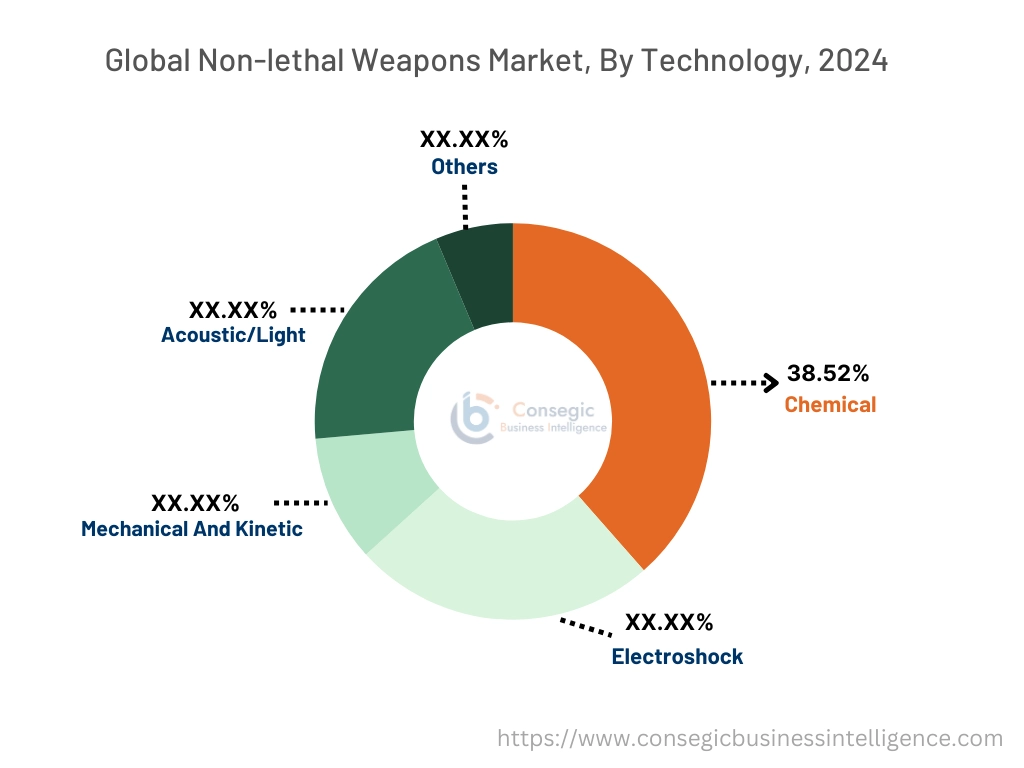
By Product Type:
Based on the product type, the market is segmented into gases and sprays, grenades, bullets, taser guns, and others.
Trends in the Product Type:
- Growing development of grenades that combine multiple effects, such as flashbangs with irritants or acoustic disrupters in turn drives the non-lethal weapons market demand.
- Increasing focus on safer detonation systems of grenades to reduce the risk of unintended injuries.
Gases and Sprays accounted for the largest revenue share in the year 2024 and is anticipated to register the fastest CAGR during the forecast period.
- Growing demand for formulations that minimize lasting health effects, focusing on rapid dissipation and targeted delivery.
- Further, integration with drones and remote-controlled systems for precise deployment in complex environments drives the non-lethal weapons industry.
- Furthermore, increasing demand for compact, easy-to-use personal defense sprays with improved accuracy and range.
- Thus, as per non-lethal weapons market analysis, enhanced formulation smart delivery systems, and increased focus on personal defense are driving the market.
By End User:
Based on the end user, the market is segmented into law enforcement agencies, military, and citizens.
Trends in the End User:
- Increased demand for personal defense tools, such as pepper spray, stun guns, and personal alarms are driving the non-lethal weapons market expansion.
- Military industry requires a range of non-lethal options for tasks such as peacekeeping, crowd control, and base security which subsequently propels the market.
Law enforcement agencies accounted for the largest revenue share in the year 2024 and is anticipated to register the fastest CAGR during the forecast period.
- The law enforcement agencies are increasingly prioritizing non-lethal options to minimize the use of deadly force and enhance community relations which is driving the market.
- Further, increasing use of wearable cameras, data logging in tasers, and other technologies is driving the market.
- Furthermore, increasing emphasis on comprehensive training programs to ensure proper and ethical use of non-lethal weapons which in turn drives non-lethal weapons market growth.
- For instance, Axon Enterprise, Inc. offers TASER 7, which is a tactical device designed to enhance de-escalation and close-range confidence for law enforcement.
- Thus, based on analysis, aforementioned factors are driving the non-lethal weapons market expansion.
Regional Analysis:
The regions covered are North America, Europe, Asia Pacific, the Middle East and Africa, and Latin America.
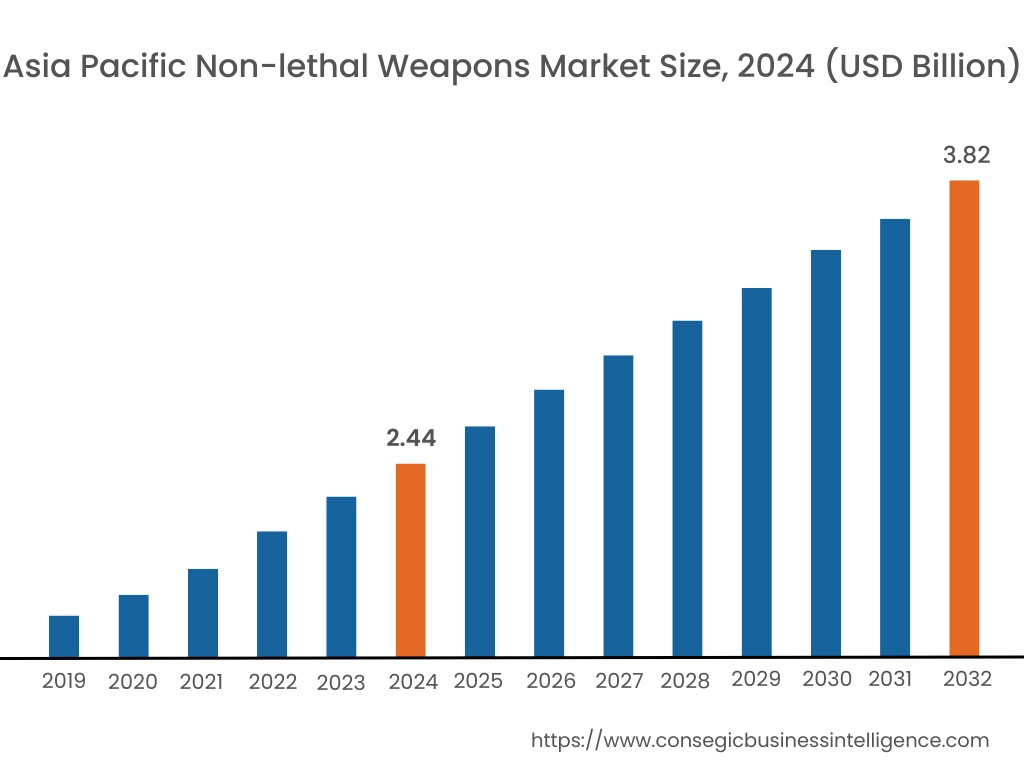
Asia Pacific region was valued at USD 2.44 Billion in 2024. Moreover, it is projected to grow by USD 2.54 Billion in 2025 and reach over USD 3.82 Billion by 2032. Out of this, China accounted for the maximum revenue share of 40.07%. As per analysis, the market growth for non-lethal weapons is mainly driven by increasing urbanization and the subsequent rise in civil unrest, necessitating effective crowd control solutions for law enforcement and security agencies.
- For instance, Combined systems, Inc. a major player in the global market offers a wide range of products including impact munitions, irritant munitions, flash-bangs & sting-ball grenades, launching systems and others
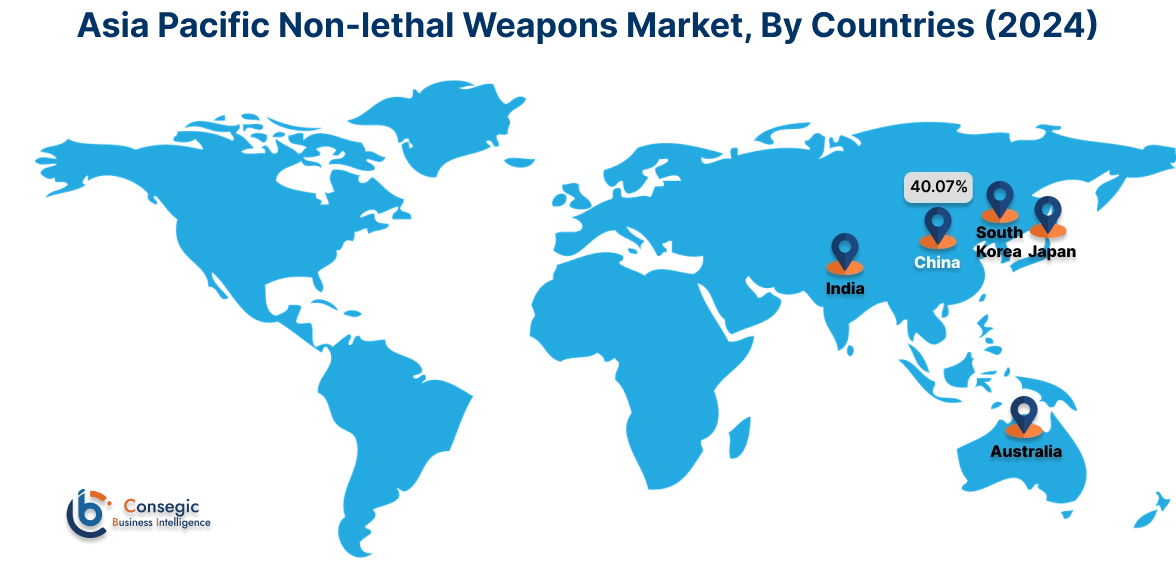
North America is estimated to reach over USD 4.36 Billion by 2032 from a value of USD 2.88 Billion in 2024 and is projected to grow by USD 2.99 Billion in 2025. The North American market is primarily driven by strong emphasis on law enforcement modernization, significant investments in defense technologies and the growing demand for effective security solutions.
- In January 2023, Axon Enterprise Inc. launched the TASER 10, marking a step towards goal of reducing gun-related deaths between police and the public by 50% in the next decade.
The regional trends analysis depicts that stringent regulation and rising concerns over terrorism and the need for proportionate responses in security operations in Europe is driving the market growth. Additionally, the factors driving the market in the Middle East and African region are escalating regional conflicts, terrorism threats, and the need for effective crowd control. Further, based on analysis, high crime rates and social unrest results in growing demand for effective crowd control and law enforcement tools which in turn pave the way for the progress of market trends in Latin America region.
Top Key Players and Market Share Insights:
The global non-lethal weapons market is highly competitive with major players providing solutions to the national and international markets. Key players are adopting several strategies in research and development (R&D), product innovation, and end-user launches to hold a strong position in the non-lethal weapons industry. Key players in the global non-lethal weapons market include-
- Axon Enterprise, Inc. (US)
- AMTEC Less-Lethal Systems Inc. (US)
- PepperBall Technologies, Inc (US)
- NonLethal Technologies, Inc. (US)
- Condor Non-Lethal Technologies (Brazil)
- Fiocchi Munizioni S.p.A. (Italy)
- Byrna Technologies Inc. (US)
- Combined Systems, Inc. (US)
- FN Herstal (Belgium)
- ISPRA LTD (Israel)
- Lamperd Less Lethal (Canada)
- Genasys Inc (US)
Recent Industry Developments :
Collaborations and Partnerships:
- In February 2024, AARDVARK announced a new partnership with Combined Systems, Inc. (CSI) for the sale and distribution of CTS Less-Lethal Products and Penn Arms Launchers.
Non-Lethal Weapons Market Report Insights :
| Report Attributes | Report Details |
| Study Timeline | 2019-2032 |
| Market Size in 2032 | USD 13.25 Billion |
| CAGR (2025-2032) | 5.8% |
| By Technology |
|
| By Product Type |
|
| By End User |
|
| By Region |
|
| Key Players |
|
| North America | U.S. Canada Mexico |
| Europe | U.K. Germany France Spain Italy Russia Benelux Rest of Europe |
| APAC | China South Korea Japan India Australia ASEAN Rest of Asia-Pacific |
| Middle East and Africa | GCC Turkey South Africa Rest of MEA |
| LATAM | Brazil Argentina Chile Rest of LATAM |
| Report Coverage |
|
Key Questions Answered in the Report
How big is the non-lethal weapons market? +
The non-lethal weapons market is estimated to reach over USD 13.25 Billion by 2032 from a value of USD 8.71 Billion in 2024 and is projected to grow by USD 9.03 Billion in 2025, growing at a CAGR of 5.8% from 2025 to 2032.
What specific segmentation details are covered in the non-lethal weapons report? +
The non-lethal weapons report includes specific segmentation details for technology, product type, end user, and regions.
Which is the fastest segment anticipated to impact the market growth? +
In the non-lethal weapons market, gases and sprays are the fastest growing segment during the forecast period.
Who are the major players in the non-lethal weapons market? +
The key participants in the Non-Lethal Weapons market are Axon Enterprise, Inc. (US), AMTEC Less-Lethal Systems Inc. (US), PepperBall Technologies, Inc (US), NonLethal Technologies, Inc. (US), Condor Non-Lethal Technologies (Brazil), Fiocchi Munizioni S.p.A. (Italy), Byrna Technologies Inc. (US), Combined Systems, Inc. (US), FN Herstal (Belgium), ISPRA LTD (Israel), Lamperd Less Lethal (Canada), Genasys Inc (US), and others.
What are the key trends in the non-lethal weapons market? +
The non-lethal weapons market is being shaped by several key trends including increasing demand for more humane and precise technologies, a growing focus on de-escalation tactics, and the development of advanced directed energy weapons and smart munitions with enhanced control.
